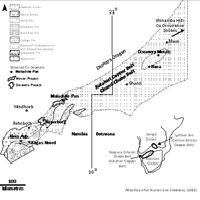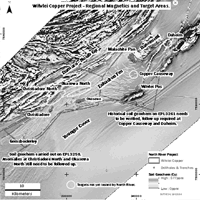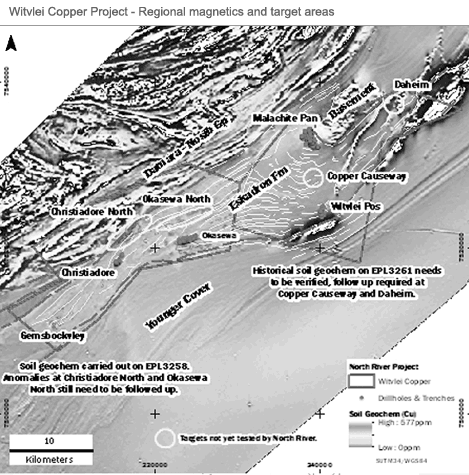
Operations
Namibia - Witvlei Copper Project
The Witvlei Copper Project covers seven known copper prospects located over a region of 550km2 (EPL 3258 and 3261). North River is currently re-assessing all previous drilling results with the aim of identifying areas for specific follow up at Malachite Pan, Okasewa, Christiadore, Witvlei Pos and Gemsbockvley.
The initial focus is on the Malachite Pan Prospect where the Company issued a maiden JORC Compliant Resource in February 2012.
Copper mineralisation at the Witvlei Project forms part of the belt of copper deposits within the Kalahari Copperbelt/Ghanzi Chobe Belt (KCB/GCB). Copper mineralisation is hosted by grey green coloured (reduced), shale-siltstone-carbonate rocks in contact with pink coloured (oxidised) quartzites and conglomerates. This style of mineralisation is typical of sediment hosted copper deposits found in the KCB/GCB in Namibia and Botswana and also elsewhere e.g. Central African Copperbelt and Kupferschiefer (also see North River's Dordabis Project).
Malachite Pan
In February 2012 a maiden resource from Malachite Pan was published which is detailed in the table below:
Tonnes |
Cu |
Cu |
Ag |
Ag |
|
% |
Tonnes |
g/tonne |
Oz |
||
| Indicated | 2,625,300 |
1.36 |
35,699 |
7.47 |
631,000 |
| Inferred | 2,368,400 |
1.11 |
26,402 |
6.19 |
471,000 |
62,101 |
1,102,000 |
Importantly, the Malachite Pan deposit is open down-dip and to the south-east providing further potential resource upside. The Board believes the Company has the potential to grow the current resource inventory substantially following the completion of further exploration activities on the Malachite Pan extensions.
In addition, the Company received highly encouraging results from metallurgical testwork completed on samples from Malachite Pan. The metallurgical testwork showed that excellent copper and silver recoveries are achievable at Malachite Pan using froth flotation, which the Board believes demonstrates encouraging economic potential.
For the purpose of the testwork, samples from Malachite Pan were segregated into two composite samples, one representing the oxide fraction of the deposit, the other the sulphide fraction. Recoveries of 82.4% copper and 77.7% silver were achieved from the oxide sample and recoveries of 92.8% copper and 83.5% silver were achieved from the sulphide sample.
Okasewa
At Okasewa, a total of 228 RC holes (36,290m) and eight diamond drill-holes (1,809m) have been drilled with best results including:
- 54m @ 1.5% Cu
- 51m @ 1.0% Cu
- 37m @ 1.8% Cu
- 34m @ 1.0% Cu
- 108m @ 1.21% Cu
- 22m @ 1.60% Cu
The Okasewa deposit is made up of three distinct zones of mineralisation (North East, Central and South West Zones) which occur within a 1,200m long package of sedimentary rocks. All the mineralisation in these three zones remains open at depth.
An in-house (non-JORC) inferred resource of 4.60Mt @ 1.14% Cu and 4.4g/t Ag (0.5% Cu cut-off), representing 52,300 tonnes Cu in-situ metal has been calculated for the Okasewa deposit.
Additional work is required to better constrain the controls on the mineralisation and this will largely be guided by work at Malachite Pan.
Christiadore
A total of 32 RC holes totalling 4,434m have demonstrated significant copper intersections including:
- 9m @ 2.5% Cu
- 7m @ 2.9% Cu
- 5m @ 3.7% Cu
Other Prospects
Work has also been carried out at Witvlei Pos and Gemsbockvley and reconnaissance work is planned for the Daheim and Copper Causeway Prospects as part of the regional programme.
Witvlei PosA further 4,000m has been drilled at the Witvlei Pos Prospect. Minor copper mineralisation was intersected, but could not repeat the values obtained by previous explorers in the 1960s and 1970s.
GemsbockvleyNo drilling has taken place at the Gemsbockvley Prospect and minor copper mineralisation has been detected in trenching.
No previous work has been carried out by the company at the Daheim and Copper Causeway Prospects. The Daheim Target in particular requires further follow up based on limited soil geochemistry and drilling results obtained by previous explorers, including unconfirmed values of 3m at 1.8% Cu in diamond drill-holes.



